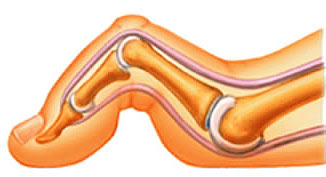A condition where a toe is bent or contracted. It usually occurs in the second, third or fourth toe. Hammertoes themselves usually are not painful, however the friction of them rubbing against the inside of shoes can create a build-up of thick, hard skin (a corn), which can be very uncomfortable.
Causes

Hammertoes are usually the result of foot misalignment. Although the condition may be inherited, usually over-pronation causes the tendons on the bottom of the foot to pull on a funny angle, causing a buckling or bending of the toe. Over time, a toe can become fixed in a bent position. Corns, which form as a result of rubbing inside of shoes, are actually a type of protective layer of thick skin over one of the toe joints. Tight or ill-fitting (running) shoes, which rub against the toe, will tend to make this condition worse.
Treatment
It is always best to try to catch this, or any condition, in the earlier stages, before the toe becomes fixed or rigid. Orthotics can often serve to correct the biomechanical faults, which cause the hammertoe. There are also over-the-counter devices called hammertoe crest pads, which serve to try to move your toe back into a normal position, assuming it is not rigid or fixed. Corns can be removed with pumice stones or by a podiatrist quickly and painlessly in the office. Toe joints that are susceptible to recurrent corns can be protected with moleskin or other pads. If the toe is in a fixed or rigid bent position, the choices are either to put up with the discomfort, get deeper or more accommodating shoes or undergo a relatively minor surgical procedure to correct the contracted joint.
Prevention
Make sure your shoes are wide enough and deep enough in order to prevent rubbing or friction irritation and the formation of a corn. Motion-control shoes and / or orthotics can serve to reduce any over-pronation.
Activity Restrictions
None really. It depends on the severity of pain.